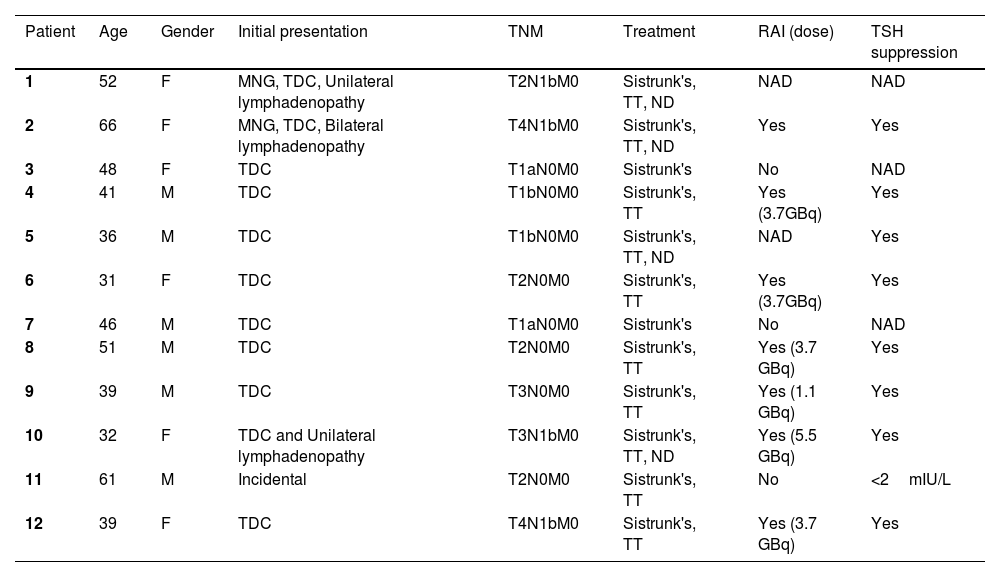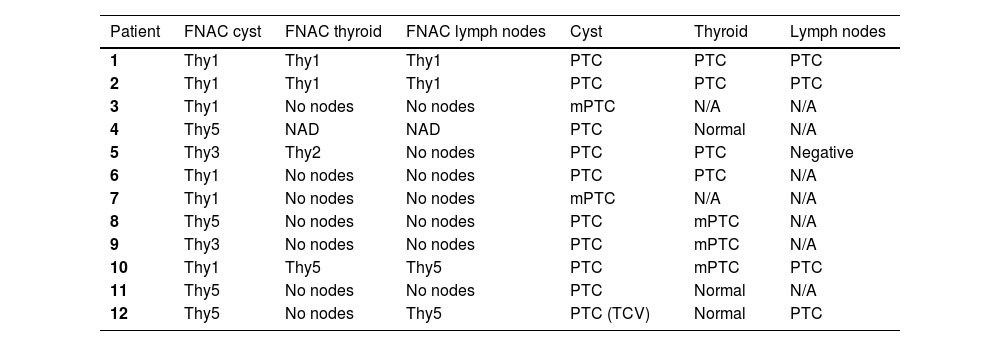To review the clinical presentation, diagnosis, pathology and management strategies in a modern cohort of patients with thyroglossal duct cyst carcinoma.
Study designRetrospective case series following PROCESS Guidelines.
SettingComprehensive cancer centre.
MethodsData recorded included: gender, age at diagnosis, clinical presentation, thyroid function, diagnostic investigations, cytological results, final histology, staging and follow up status. The risk of malignancy in cytological analysis was stratified according to the Royal College of Pathologists classification in United Kingdom.
ResultsTwelve patients were included. The majority of patients (66.7%) presented with an isolated thyroglossal duct cyst. Only 4 patients had preoperative cytological suspicion of carcinoma (sensitivity: 33.3%). At the time of presentation all patients were euthyroid. Following diagnosis of malignancy, a total thyroidectomy was performed in all patients, with the exception of 2, who had a thyroglossal duct cyst carcinoma of less than 10mm. Among the 10 patients who underwent total thyroidectomy, 7 (70%) patients had proven carcinoma in the thyroid gland, 3 with deposits of less than 10mm. The average size of the thyroid cancer deposits was 7.2mm (1–20mm). With a mean follow-up of is 44 months (5–120), all patients were alive and free of recurrence at the end of the study period.
ConclusionThyroglossal duct cyst carcinoma is a rare condition and its management should be discussed in a multidisciplinary meeting. As with differentiated thyroid cancer originating in the thyroid gland, it bears extraordinary survival rates. Accordingly, the management of these cancers has shifted towards a more conservative approach although its peculiarities must be taken into account: ease of extracystic invasion and possible different lymph node invasion.
Revisar la presentación clínica, el diagnostico, la histología y las estrategias de tratamiento en una cohorte moderna de pacientes con carcinoma del conducto tirogloso.
Diseño del estudioSerie de casos retrospectiva utilizando PROCESS Guidelines.
LocalizaciónUnidad de cáncer de cabeza y cuello.
MétodosLos datos incluidos fueron: sexo, edad al diagnóstico, presentación clínica, función tiroidea, investigaciones diagnósticas, resultados citológicos, histología final, estadificación y estado durante el seguimiento. El riesgo de malignidad en el análisis citológico fue estratificado de acuerdo con la clasificación del Royal College of Pathologists del Reino Unido.
ResultadosSe incluyeron 12 pacientes. La mayoría de ellos (66,7%) presentaron solamente un quiste del conducto tirogloso al diagnóstico. Solamente 4 pacientes tuvieron sospecha de malignidad de acuerdo con los resultados de la citología preoperatoria. En el momento de la presentación, todos los pacientes tenían función tiroidea normal. Después del diagnóstico, se realizó tiroidectomía total a todos los pacientes menos dos, que tuvieron carcinoma del conducto tirogloso menor de 10mm. Entre los 10 pacientes que recibieron tiroidectomía total, 7 (70%) sufrieron carcinoma en la glándula tiroides, 3 de ellos con depósitos menores de 10mm. El tamaño medio de los depósitos de carcinoma en la glándula tiroides fue de 7,2mm (1-20mm). Con una media de seguimiento de 44meses (5-120), todos los pacientes estaban vivos y libres de recidiva al final del periodo estudiado.
ConclusiónEl carcinoma del conducto tirogloso es una entidad poco frecuente y su manejo debe ser realizado por un equipo multidisciplinario. Igual que en el carcinoma diferenciado de tiroides que se origina en la glándula tiroides, las tasas de supervivencia son excelentes. De acuerdo con estos resultados, el tratamiento de estos carcinomas ha evolucionado hacia un manejo más conservador, aunque las peculiaridades de este tumor no pueden ser olvidadas: facilidad para la invasión extraquiste y el posible diferente patrón de diseminación ganglionar.











